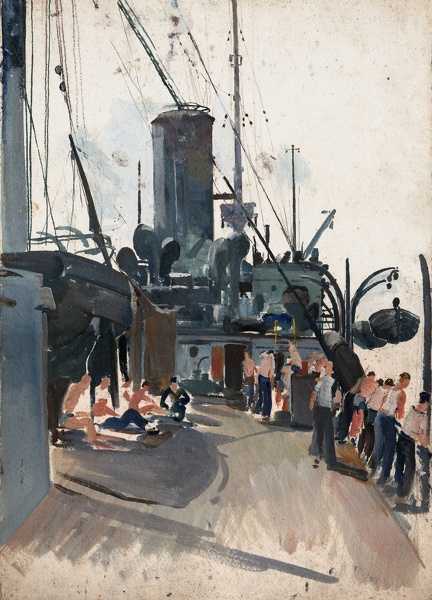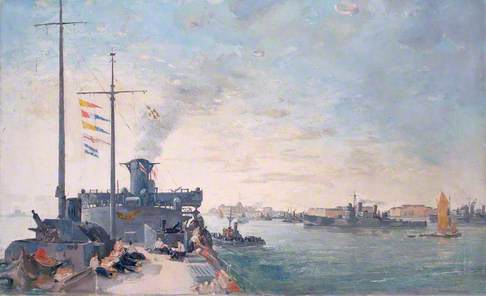
 SOLD
SOLD
Charles Cundall:
Study for Dunkirk Paddle Boat, circa 1940
Unmounted (ref: 7679)
Oil on paper
21 x 15 in. (53.3 x 38 cm)
Tags: Charles Cundall oil
Provenance: The Artist's Family
This is a study for Dunkirk Paddle Boat, currently at the Imperial War Museum;
credit Imperial War Museum; IWM_LD_6049
During WW2 Cundall was one of only thirty-seven salaried official war artists. In July 1940, the WAAC offered him a salaried six-month contract with the Admiralty, focusing on the work of the Merchant Navy: a timely subject that had been urged on the Admiralty by the Chamber of Shipping the previous spring.2 Cundall, an enthusiastic peacetime traveller, continued to be on the move during the next six months, working on naval subjects seen on the Thames and the Medway, in Cornwall (at Falmouth and St Mawes), and in the West Country. In 1941, after a brief lull following the end of his Admiralty employment early in the year, he was at last transferred to the Air Ministry, where he remained on salary until 1945. From 1941 until the end of the war his destinations included several English cities (notably Blackpool, Manchester, Liverpool and London) and counties (Kent, Somerset, Oxfordshire, Lancashire, Gloucestershire, Shropshire, Sussex, Yorkshire), various sites in Scotland (Oban, Orkney, Gourock, Rothesay, Edinburgh, Glasgow), Wales (Pembroke), Northern Ireland, the Channel Islands, and even Germany, where he recorded the wrecked bulk of the German pocket battleship Admiral Scheer in the summer of 1945.
The gusto that Cundall brought to his employment endeared him to members of the WAAC. So did his credentials; by 1940 he had a reputation on the national art scene as a member of the New English Art Club, the Royal Society of Portrait Painters and the Royal Society of Painters in Water-Colours. He had been made an associate member of the Royal Academy in 1937 (he would become a full academician in March 1944), and was a veteran of well-received solo exhibitions at London’s Colnaghi gallery. He also had solid experience of what battle was like. From 1914 to 1917 he had fought with the Royal Fusiliers and had suffered so severe an injury to his right hand that he was forced to paint thereafter with his left.However, the most attractive factor for the WAAC was that in the years since the mid-1920s Cundall had specialized in creating unified compositions out of complex, potentially confusing scenes – initially sporting matches, although his repertoire had expanded to embrace other events (such as Bank Holiday, Brighton, purchased for the Tate Gallery in 1933) involving large numbers of people spread over panoramic landscapes. “Such subjects are not aesthetic in58themselves,” wrote one critic in a later appreciation, “and can only be made so by a kind of imaginative concentration, plus an insatiable curiosity in democracy at play.” Modern warfare, with its vast fields of action, must have seemed the next logical step for an artist with these pictorial skills.
Cundall’s work was admired not only by the WAAC’s armed services representatives, but also by the committee’s three artist members. Muirhead Bone, Percy Jowett and Walter Russell were all, like Cundall, skilled academic artists. (Bone, whose drawings matched Cundall’s paintings for their compositional scale and complexity and for their wealth of precisely rendered detail, had written the catalogue foreword for his friend’s 1927 Colnaghi exhibition, praising him as a “detached observer we feel we can trust”. The WAAC ultimately accepted fifty-seven of Cundall’s paintings, on subjects ranging from naval installations to aerodromes; from aircraft under repair to flotillas of ships; from Women’s Auxiliary Air Force mechanics, to the landing of Bordeaux refugees in Falmouth in 1940 and the arrival of American troops in Northern Ireland in 1942; and from behind-the-scenes events at armed services installations, to actual combat.








